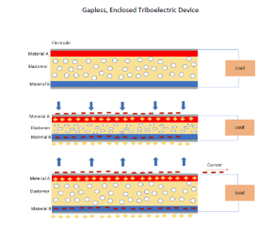Energy harvesting is an important aspect of energy efficiency. In various applications it can reduce the amount of energy required for a process or energize a device where access to power is limited or nonexistent. Of mechanical energy harvesting technologies, piezoelectrics are most widely used. Triboelectricity uses two materials with opposite properties such that when the two materials come into frictional contact with each other, surface electrons are passed from one material (donator) to the other (receiver) and remain there while in contact. When the two materials are pulled away from each other, a voltage potential is created as some of the electrons remain on the surface of the receiver material. When the materials are shorted, the movement of those surface electrons back to their parent material drives current. Most triboelectric devices rely on an air gap between the two materials to create the voltage potential.
The challenge to harvesting the energy in this manner is the existence of the air gap, which reduces the utility of these devices and constrains their application. Because air is an insulator, the electron balance cannot equalize, and the surfaces of the materials become charged.
The two primary methods for actuating triboelectric (mechanical/friction) devices are contact separation and lateral sliding. Rather than an air gap to separate the contacts and sliding, LLNL researchers have conceived of a flexible, self-contained triboelectric device that can be compressed. The key to the invention is the dual function of a flexible, compressive material that fills in the space between the two triboelectric materials. When this sandwiched device is pressed together, the spacer will allow the two triboelectric materials to be brought into proximity that then instigates the transfer of electrons; once the compression source is removed, the spacer will then provide a restorative force to separate the two materials, once again creating the voltage potential.
Promising spacer materials would be elastomeric, porous, capable of being compressed, and capable of creating its own restorative force when the compression source is removed. The spacer material must be sufficiently non-conductive, which allows the charge imbalance to occur between the two triboelectric materials without the air gap. By selecting the optimal material, the spacer would potentially take up less volume than a standard triboelectric device, yet the compact device would still be capable of generating the same amount of power.
This invention can potentially:
- Reduce the volume of the triboelectric device to a thin film
- Improves mechanical robustness of the device
- Longer lifetimes
- Power generating: triboelectric fibers for sustainable, environmentally-friendly energy source for wearable applications
- Energy harvesting: air-gapless triboelectric devices used to collect waste/ambient energy from mechanical systems or harvest energy from green sources such as wind or water.
- Sensor applications: a thin film triboelectric device could be applied to surfaces of materials to record touch (force) or impact.
Current stage of technology development: TRL 2
U.S. Patent Application No. 2022/0255463 Artificial Air Gap Triboelectric Device For Applications In Sensors, Power Generation And Energy Harvesting published 8/11/2022


